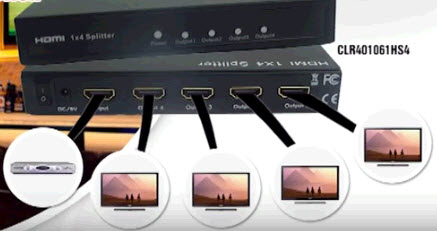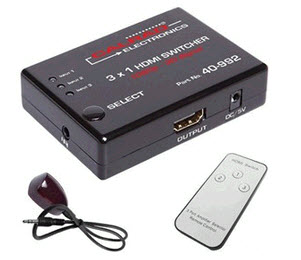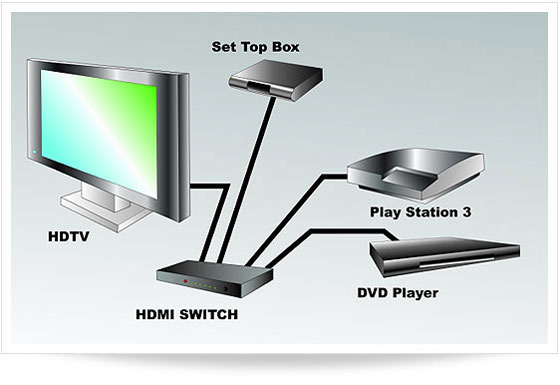
Are you an AV tech looking to figure out the best way to connect multiple devices on a home theater installation? Or perhaps you’re a tech-savvy consumer trying to connect everything from your DVD player to your gaming console and laptop to your big screen TV.
To do the above, your best option is to use an HDMI splitter or an HDMI switcher, and in this post we’ll do a complete run down on which one to use when and how to connect multiple devices through HDMI.
So let’s get started. First, no matter how new your television model is it only comes with a limited number of ports, and most likely not more than two HDMI ports. Secondly, you can use other ports, but understand that analog ports are now becoming obsolete with the emergence of digital ones, and that an HDMI port is by far the best way to transfer signals between two devices at lightning speed today.
Using HDMI (High Definition Multimedia Interface) you can create the best possible home theater experience by having just one cable provide you with the best quality picture and high quality sound.
However, if you need to facilitate the viewing of HDTV video content on televisions, projectors, RF modulators or other devices that do not have HDMI inputs you can use an HDMI converter that converts HDMI signals to VGA video & audio. For example, Calrad’s 40-284A HDMI to VGA Video and Audio Converter Cable works perfectly for connecting video cards (desktop or laptop) or consumer electronics devices such as game consoles or home theater receivers that offer an HDMI Out port to a VGA display.
When to use an HDMI Splitter

You can use an HDMI splitter to connect and operate multiple devices through one HDMI port. An HDMI splitter simply has a cable with an HDMI plug on one side and on the other side (depending on the HDMI splitter type) you can have two, three and even four HDMI ports. So for example you can connect a DVD player to the HDMI plug on one side and connect three television displays on the other side. It basically ‘splits’ the connection allowing you to connect more than one TV to one HD source.
Now here’s the tricky part – If you run too many devices at once, or in technical terms if you send signals from multiple devices to one TV, you may run into some issues such as overlapping and poor quality signal transmissions even with just one device actually turned on – in this case you will need an HDMI switcher.
When to use an HDMI Switcher
For high quality transmission and performance when connecting multiple devices to your TV, an HDMI switch or switcher is your best solution. To switch between devices, you can either manually select the device on the HDMI switch itself, or use a remote control that is included with most HDMI switches, to select the device. Newer HDMI switches also offer an automatic switching option where the switch automatically selects the device that got powered on the most recently. Also with an HDMI switch you get the added advantage of using longer HDMI cables if your current setup requires that option.
 Calrad’s 3 x 1 HDMI switcher routes high definition video (in multiple resolutions up to 1080p) and digital audio from any one of the three sources to a video display unit. Aside from the manual switching, the 40-992 can also be controlled via the IR remote that is provided or the switcher will automatically switch to new source signals when other input devices are turned on.
Calrad’s 3 x 1 HDMI switcher routes high definition video (in multiple resolutions up to 1080p) and digital audio from any one of the three sources to a video display unit. Aside from the manual switching, the 40-992 can also be controlled via the IR remote that is provided or the switcher will automatically switch to new source signals when other input devices are turned on.
Features & Benefits of the Calrad 3 x 1 HDMI Switcher:
- HDTV Resolutions: 480p, 720p, 1080i, 1080p (Max 10.2Gbps, HDMI HIGH SPEED)
- 12 Bit Deep Color
- HDMI In\Out Connectors: 19 pin 24k Gold Plated Female Jacks
- IR Cable Receiver Cable length: 3 Ft.

Source: http://www.relay-switch-manufacturer.com/rimages/620/HDMI-switch-pic.jpg
Splitter or Switch?
Still confused? To explain it simply if you want to watch your favorite TV show, browse the internet, play a video game and run some MP3 tracks in the background, all at once, you definitely need to get an HDMI switch. But let’s say that, for example, you always keep your Blu-Ray player connected to your television and occasionally also want to play video footage you took on your camcorder on your TV, then an HDMI splitter should be good enough to do the job. It really all depends on what your individual needs are.
HDMI Extenders
In home installation cases where you don’t want to run costly HDMI cables through walls and cabinetry and don’t want to sacrifice signal transmission and quality either, an HDMI extender is a perfect solution. Calrad’s 40-1091 is an HDMI & IR Extender Over Single CAT5/6 Cable. It comes with a transmitter and receiver and is designed for extending an HDMI & IR signal over one CAT5/5e/6 cable. (We recommend CAT6 cable, especially if you want to transmit a 3D signal).
View the video below to learn more:
If you live in or close to Burbank, California drop by our audio video store and we’ll be happy to help you pick an HDMI interface that’s right for you. Not in the area? You can now conveniently shop online on our website, and as always if you have a question about a product on our site or need an item ordered in, our in-store reps are happy to get on the phone with you and help you out. Simply call 800.634.9476 and we look forward to serving you!

Hi
how can i connect my AV-Receiver to my TV which only has a HDMI-Port?
Tom